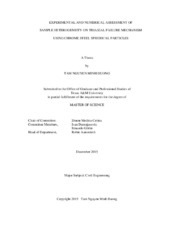| dc.contributor.advisor | Medina-Cetina, Zenon | |
| dc.creator | Duong, Tam NM | |
| dc.date.accessioned | 2020-02-28T17:20:14Z | |
| dc.date.available | 2020-02-28T17:20:14Z | |
| dc.date.created | 2015-12 | |
| dc.date.issued | 2015-12-09 | |
| dc.date.submitted | December 2015 | |
| dc.identifier.uri | https://hdl.handle.net/1969.1/187460 | |
| dc.description.abstract | Previous studies have shown that sample preparation techniques used to reconstruct specimens for granular materials can have substantial influence on theirs mechanistic behavior. Since the Distinct Element Method (DEM) becomes popular for modeling multi-physics problems using granular materials, the homogeneity of reconstituted samples should be investigated and accurately characterized in order to have consistent modeling results. The air pluviation method was used to reconstitute samples composed of a homogeneous granular material at different density conditions. Then, selected samples were taken to perform triaxial compression tests in order to obtain the global strength behavior of the specimen under compression loading. X-ray computed tomography (CT) and image analysis techniques were later used to characterize the spatial particle structure of a sample. The sample preparation method and compression test were modeled numerically using discrete element method via a program called PFC3D from ITASCA. The microstructure of the numerical sample was compared to the results of the image analysis to determine if the heterogeneity of the sample could be accurately replicated in DEM by measuring void ratio of the reconstituted samples. In addition, the engineering response of numerical sample under compression was also compared with experimental results. Experimental results showed the sample heterogeneity was affected by sample preparation conditions thus influenced on its stress-strain response when subjected to triaxial compression. Although direct comparison of spatial void ratio between the experimental samples and the numerical models was not obtained, the comparison of spatial void ratio of the numerical models created by air pluviation method and radius expansion method showed that the void ratio of samples prepared by air pluviation method had lower percentage error with the global experimental void ratio. Due to time limitation, only four numerical simulations of triaxial compression were performed. | en |
| dc.format.mimetype | application/pdf | |
| dc.language.iso | en | |
| dc.subject | Granular materials | en |
| dc.subject | Air pluviation | en |
| dc.subject | X-rays computed tomography | en |
| dc.subject | PFC3D | en |
| dc.title | Experimental and Numerical Assessment of Sample Heterogeneity on Triaxial Failure Mechanism Using Chrome Steel Spherical Particles | en |
| dc.type | Thesis | en |
| thesis.degree.department | Civil Engineering | en |
| thesis.degree.discipline | Civil Engineering | en |
| thesis.degree.grantor | Texas A&M University | en |
| thesis.degree.name | Master of Science | en |
| thesis.degree.level | Masters | en |
| dc.contributor.committeeMember | Damnjanovic, Ivan | |
| dc.contributor.committeeMember | Gildin, Eduardo | |
| dc.type.material | text | en |
| dc.date.updated | 2020-02-28T17:20:17Z | |
| local.etdauthor.orcid | 0000-0003-1448-3237 | |


